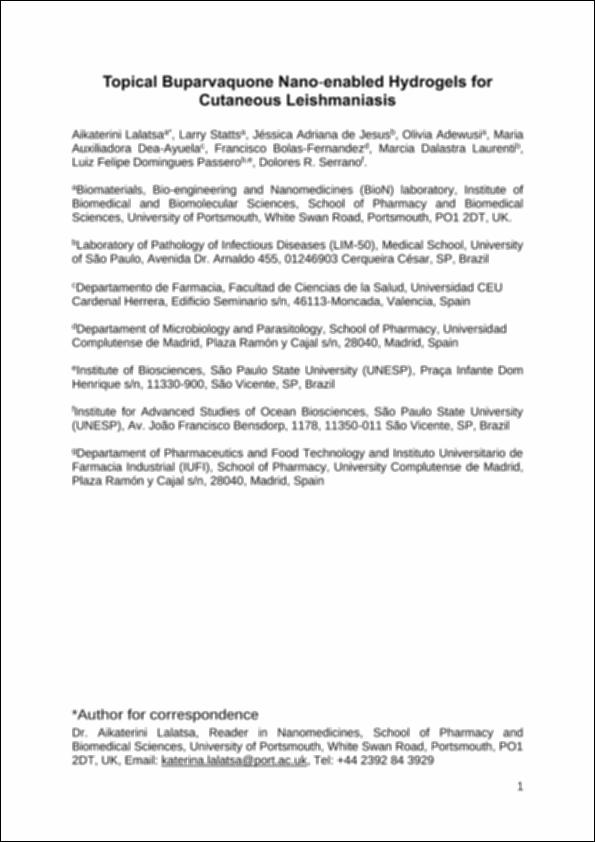Por favor, use este identificador para citar o enlazar este ítem:
http://hdl.handle.net/10637/13020Topical buparvaquone nano-enabled hydrogels for cutaneous leishmaniasis
| Título : | Topical buparvaquone nano-enabled hydrogels for cutaneous leishmaniasis |
| Autor : | Lalatsa, Katerina Statts, Larry Jesus, Jéssica A. de Adewusi, Olivia Dea Ayuela, María Auxiliadora Bolás Fernández, Francisco |
| Materias: | Buparvaquone - Therapeutical use.; Leishmaniasis.; Piel - Enfermedades.; Buparvaquone - Uso terapéutico.; Zoonoses.; Zoonosis.; Skin - Diseases. |
| Editorial : | Elsevier. |
| Citación : | Lalatsa, A., Statts, L. Jesus, J.A. de, Adewusi, O., Dea-Ayuela, M.A., Bolas-Fernandez, F. et al. (2020). Topical buparvaquone nano-enabled hydrogels for cutaneous leishmaniasis. International Journal of Pharmaceutics, vol. 588 (15 oct.), art. 119734. DOI: https://doi.org/10.1016/j.ijpharm.2020.119734 |
| Resumen : | Leishmaniasis is a neglected disease presenting cutaneous, mucosal and visceral forms and affecting an estimated 12 million mostly low-income people. Treatment of cutaneous leishmaniasis (CL) is recommended to expedite healing, reduce risk of scarring, prevent parasite dissemination to other mucocutaneous (common with New World species) or visceral forms and reduce the chance of relapse, but remains an unmet need. Available treatments are painful, prolonged (>20 days) and require hospitalisation, which increases the cost of therapy. Here we present the development of optimised topical self-nanoemulsifying drug delivery systems (SNEDDS) loaded with buparvaquone (BPQ, a hydroxynapthoquinone from the open Malaria Box) for the treatment of CL from New World species. The administration of topical BPQ-SNEDDS gels for 7 days resulted in a reduction of parasite load of 99.989 ± 0.019 % similar to the decrease achieved with intralesionally administered Glucantime® (99.873 ± 0.204 %) in a L. amazonensis BALB/c model. In vivo efficacy was supported by ex vivo permeability and in vivo tape stripping studies. BPQ-SNEDDS and their hydrogels demonstrated linear flux across non-infected CD-1 mouse skin ex vivo of 182.4 ± 63.0 μg cm-2 h-1 and 57.6 ± 10.8 μg cm-2 h-1 respectively localising BPQ within the skin in clinically effective concentrations (227.0 ± 45.9 μg and 103.8 ± 33.8 μg) respectively. These levels are therapeutic as BPQ-SNEDDS and their gels showed nanomolar in vitro efficacy against L. amazonensis and L. braziliensis amastigotes with excellent selectivity index toward parasites versus murine macrophages. In vivo tape stripping experiments indicated localisation of BPQ within the stratum corneum and dermis. Histology studies confirmed the reduction of parasitism and indicated healing in animals treated with BPQ-SNEDDS hydrogels. These results highlight the potential clinical capability of nano-enabled BPQ hydrogels towards a non-invasive treatment for CL. |
| Descripción : | Este artículo se encuentra disponible en la siguiente URL: https://www.sciencedirect.com/science/article/abs/pii/S0378517320307183 Nota de Fondos: Esta versión preprint del artículo se encuentra a texto completo en el CEU Repositorio Institucional. En esta investigación también participan: Marcia Dalastra Laurenti, Luiz Felipe Domingues Passero y Dolores R. Serrano. This is the pre-peer reviewed version of the following article: Lalatsa, A., Statts, L., Jesus, J.A. de, Adewusi, O., Dea-Ayuela, M.A., Bolas-Fernández, F. et al. (2020). Topical buparvaquone nano-enabled hydrogels for cutaneous leishmaniasis. International Journal of Pharmaceutics, vol. 588 (15 oct.), art. 119734, which has been published in final form at https://doi.org/10.1016/j.ijpharm.2020.119734 Este es el pre-print del siguiente artículo: Lalatsa, A., Statts, L., Jesus, J.A. de, Adewusi, O., Dea-Ayuela, M.A., Bolas-Fernández, F. et al. (2020). Topical buparvaquone nano-enabled hydrogels for cutaneous leishmaniasis. International Journal of Pharmaceutics, vol. 588 (15 oct.), art. 119734, que se ha publicado de forma definitiva en https://doi.org/10.1016/j.ijpharm.2020.119734 |
| URI : | http://hdl.handle.net/10637/13020 |
| Derechos: | http://creativecommons.org/licenses/by-nc-nd/4.0/deed.es |
| ISSN : | 0378-5173. |
| Fecha de publicación : | 15-oct-2020 |
| Centro : | Universidad Cardenal Herrera-CEU |
| Aparece en las colecciones: | Dpto. Farmacia |
Los ítems de DSpace están protegidos por copyright, con todos los derechos reservados, a menos que se indique lo contrario.


